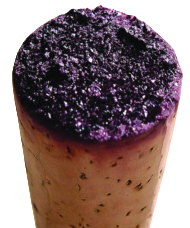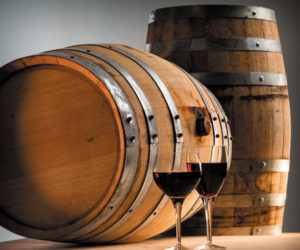Q
If potassium bicarbonate was added to my must (or juice for my whites) and my acid now is where I want it, do I still have to move it outside to cold stabilize? I am only in my third year of winemaking and The first two years I added potassium bicarbonate (KHCO3) in February and moved my high-acid wine outside for a week or so in hopes to lower acidity. This year I was advised to try adding it at the start (September/October). I did and now my acid is where I want it.
Roy McGuill
Monson, Massachusetts
A
I always think that trying to precipitate out some of the worst crystals that could form is a good idea, especially for any wine that may be sold commercially or entered into competitions. You probably won’t change your pH/titratable acididty (TA) balance that much. In my experience, doing a traditional cold stability where you chill the wine down and then filter off any precipitation won’t shift the acidity enough to notice it in the taste. It’s far better that you got it down to where you liked it style-wise in the first place.
If you’d rather not go through the bother of chilling and fermenting (however, this would be my top advice to prevent these crystals from forming to the sides of your bottle or bottom of the cork, as pictured to the left) and want to prevent some if not all crystals from forming, you could try adding one of the newer carboxymethyl cellulose (CMC) products that many winemaking suppliers are selling. CMC is an FDA- approved cellulose gum commonly used in food as a thickener and emulsifier. If you add 1 mL of CMC per liter of wine, it actually prevents the crystals from forming even though the acid chemistry of your wine will not change. It is clear, colorless, odorless, and tasteless, and should be added after the final filtration. Be sure to wait 48 hours before bottling if you will be passing the wine through a further 0.45 micron membrane on your bottling set up; if not, you might plug your membrane.
I’ve been using CMC with great success for the past few years in many of my white and rosé wines. The only thing you need to take into account is that each product is a little different and each manufacturer may have different criteria for how you work with their CMC. Some, for example, suggest you test for how “unstable” your wine is. CMC can prevent most crystals from forming, but if you have a wine that is very unstable, the product may not be effective at stopping all crystal formation. In which case I would recommend doing a light chilling to precipitate some crystals and to make the remaining “lightly unstable” wine a candidate for the CMC approach. As I say, every manufacturer tends to have their own protocol and CMC-type product so I don’t want to single out one over the other. If you’re curious to try a new way to approach cold stability, you should look into CMC!
Q
In 2015 we had several days of very hot weather in Northern California right before harvest time. I couldn’t get my grapes off the vines fast enough and consequently my Cabernet Sauvignon and Petite Sirah came in at a very high Brix (29 and 30). They did not ferment out all the way so I tried to restart the fermentation with a high-alcohol yeast and Go-Ferm, with no success. I decided to press and SO2 the wine and save it to add to my 2016 harvest. My thought is to add 1 gallon (4 L) of 2015 Petite Sirah to 40 gallons (151 L) of must and 5 gallons (19 L) of 2015 Cab to 30 gallons (114 L) of must. Do you have any problems with my solution?
Denis C. LeBreton
Alamo, California
A
That’s too bad that you had some stuck fermentations. It’s probable that your yeast died out due to alcohol toxicity resulting from those high brixes. Next time make sure you’re adding enough water and feeding enough nutrients to create as healthy of a fermentation environment as you can. Before next harvest you may want to brush up on stuck fermentation prevention; there have been many articles published in WineMaker magazine on the topic over the years, and some are available by doing a search for the topic on winemakermag.com.
As far as dosing in some of your stuck 2015 wine to future vintages, I have a few things you may want to take into consideration before trying it. Number one is something I’ve been saying for many years and that is, “Never blend a loser.” What I mean by that is: Don’t let a small percentage of a “bad” or troubled wine ruin a future batch. While I understand the temptation to try to salvage something from a winemaking project gone wrong, there are some real reasons why it’s not a good idea. Stuck fermentations can taste and smell bad. You may negatively impact sensory quality of future batches if you mix the two. Stuck fermentations are also notorious environments for spoilage organisms — both yeast and bacteria. It’s possible that you’ll introduce some old “bad actors” like Acetobacter or Pediococci into your pristine brand new wine, thereby potentially spoiling all of 2016 wines.
My advice in this case? Dump the old stuck stuff. You’re only talking about 6 gallons (23 L) of old wine total and in my mind, it’s not worth the risk of spoiling 70 new gallons (265 L) for the sake of re-purposing 6 gallons (23 L).
Really don’t want to dump the old batch? Try adding some brandy and a sweetener to make a fortified wine gift for the holidays. Or infuse in some cinnamon, star anise, citrus peel, and cloves, and then sweeten to taste for a seasonal hot mulled wine.
Q
I make 60 gallons (227 L) of Cabernet Sauvignon each year, which i press into glass carboys. My question is, when and to what container should I add the malolactic bacteria and nutrient? Should each be added to the primary fermenter before press, should I press and add small amounts of both to all (10) carboys, or press and after two days rack each carboy adding the bacteria and nutrient to each?
Paul Mazzeo
Osterville, Massachusetts
A
I’m a little old school when it comes to malolactic fermentation, but it’s always served me well. There are some winemakers who try to get a jump on malolactic (ML) completion and co-inoculate with ML bacteria and wine yeast at the same time, but in my mind this is a little risky. You see, yeast and bacteria actually “talk” to each other during fermentation and sometimes they don’t like what they hear. In fact, Dr. Linda Bisson’s lab at UC-Davis just published a really interesting study showing how wine bacteria “query” the environment to check for competitors and adjust their metabolic process accordingly. Too many mixed messages in some cases can cause problems with fermentation completion, higher volatile acids, and other non-optimal outcomes.
The take-away for me is that I like to let the yeast do their job eating sugar first (and making carbon dioxide and alcohol) undisturbed by too many outside competitors. Once they die off after primary fermentation (and the fermentation is hopefully dry), I press off my new wine and immediately add my ML bacteria and any ML nutrients together at the same time to the container holding the new wine. If you add your ML bacteria and ML nutrients before pressing off you’ll lose a lot of the dose (and those additives are expensive!) in the skins, which get discarded. Also, once you have the wine separated from the skins you know how much wine volume you have so you can measure your bacteria and nutrients accurately. It’s really hard to tell your final liquid yield when the wine is still sitting on the skins.
I would add your malolactic bugs and nutrients evenly into your carboys right away. This way you can also take advantage of any residual warmth carried over from the primary fermentation.
Q
Circumstances caused me to pick my Merlot grapes earlier than desired (Brix=21.2, pH=3.61, TA=5.1) this past harvest. After processing them through my crusher/de-stemmer and cleaning up, I noticed a white residue/deposit on the inside surfaces of the equipment and in the catch vessel. I rinsed the equipment just after finishing, so it was not dried on, rather deposited during processing. It does not come off easily by rubbing with a finger, but scrubs off fairly easily with a scrub pad. I did not remember it from last year. Any ideas as to what it is? Many thanks.
Jim Shurts
Richland, Washington
A
I’ve had a similar experience — both with having to pick gapes at sub-optimal times (curse you, weather!) as well as having that rough white residue on my crush equipment.
The residue, which resembles a thicker than normal layer of hard water scale, comes from the grapes themselves. From what I understand, it’s simply an organic acid/mineral complex very similar to the common tartrate crystals (solidified tartaric acid) often that can collect in the bottom of bottles or barrels. I find that it comes off very easily when cleaned with TSP, “Peroxycarb” (a commercial brand of powdered sodium percarbonate) or a similar basic cleaning solution.
Always be careful when cleaning stainless steel because you don’t want to scratch, score, or pit it. These scratches, if you aren’t careful, are ideal environments for microbial spoilage organisms to hide and wreak havoc on your wine. I try to use as little force and abrasion as necessary to remove the scale; stick with gentle sponges or brushes with plastic bristles (no metal!) only. As always, when using a basic cleaning agent (pH greater than 7.0) to clean, follow by an acidic (pH less than 7.0) rinsing solution like 1⁄2 oz. (14 g) citric acid diluted in 2 gallons (8 L) of water and finally by a clean water rinse. That should do it!






